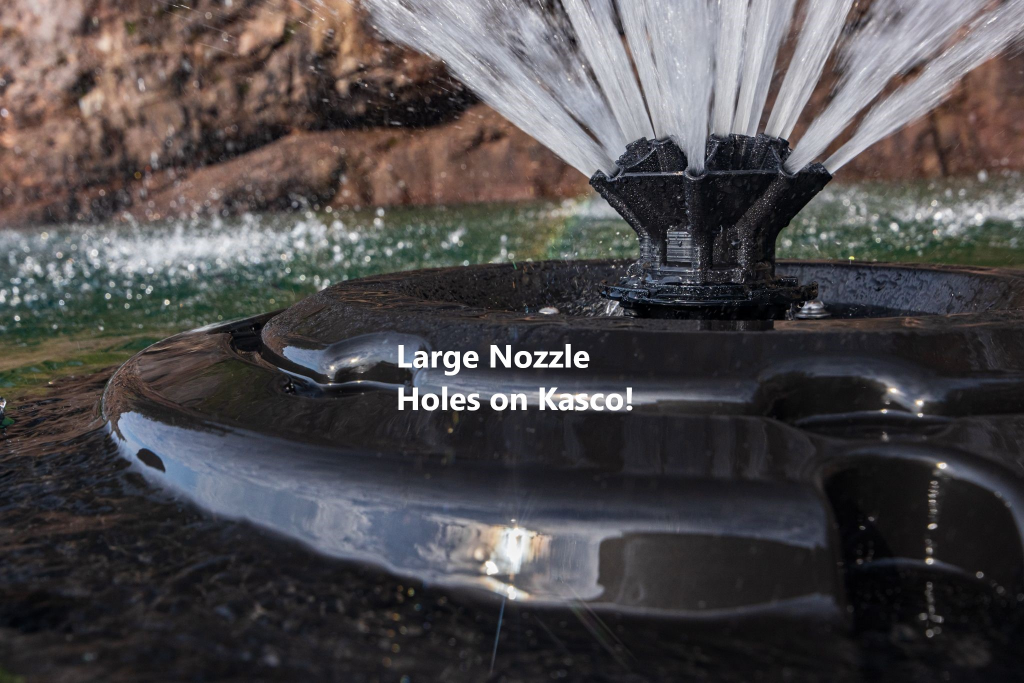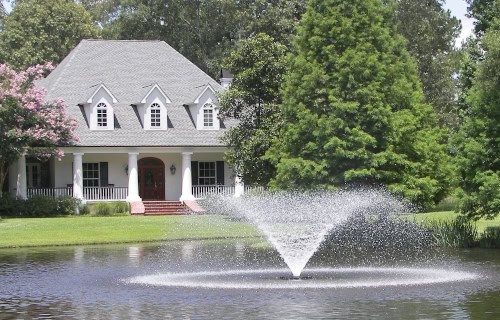A floating pond fountain can be a beautiful addition to any outdoor space, providing tranquility and visual appeal. One way to enhance the aesthetic value of your pond is by adding a floating fountain. Not only do these fountains create a stunning display of water, but they also offer practical benefits such as aeration and circulation. However, choosing the right one can be daunting with a wide range of floating fountains in the market.
Pond fountains create a captivating visual spectacle as they gracefully propel water upward from the center of lakes, ponds, and various water bodies. While their aesthetic appeal is undeniable, these floating fountains offer concealed advantages that enhance their allure. Beyond the surface beauty lies a multitude of benefits, particularly concerning the overall well-being of the ecosystem.
What Size Floating Fountain to Choose?
Floating fountains have gained popularity as captivating water features in ponds, lakes, and other water bodies. They enhance the aesthetic appeal, improve water quality, and provide a soothing atmosphere. However, choosing the right size for a floating pond fountain is crucial to ensure optimal performance and visual impact.
Understanding Fountain Size Options
Regarding floating fountains, various size options are available, typically categorized by the horsepower (HP) of the fountain’s motor. The size of the fountain and the kind of nozzle used directly impacts factors such as water height, spray pattern, and overall visual effect. Here are some key factors to consider when choosing the size of your floating fountain:
Pond or Lake Size
The size of your water body plays a vital role in determining the appropriate fountain size. Larger bodies of water require more powerful fountains to create a visually impressive display. A small pond may benefit from a 1/2 HP or 1 HP fountain, while larger lakes may need 3 HP or higher to create a dramatic effect. Even more important in your determination is degree of effectiveness of aeration. Here are recommendations for Kasco units:
Kasco recommends:
Pond Size, Horsepower Needed for Effective Aeration
| Pond Size | Decorative Fountain | Aerating Fountain | Aerator |
| ½ acre | 1 HP | ¾ HP | ½ HP |
| 1 acre | 2 HP | 1 ½ HP | 1 HP |
| 2 acre | 4 HP | 3 HP | 2 HP |
| 3 acre | 6 HP | 4.5 HP | 3 HP |
| 5 acre | 10 HP | 7.5 HP | 5 HP |
Note that these recommendations are for Kasco fountains only. Many if not most other manufacturers aerate quite less efficiently than Kasco units. A decorative fountain is a fountain that includes a nozzle to create the display pattern. An aerating fountain does not include a nozzle; instead, the propeller creates a “V” pattern only. As you can see above, aerating fountains aerate more than decorative fountains. A plain aerator has no real display other than large bubbles on the surface but aerate most effectively. Also note that these measurements above are for output horsepower, not input horsepower, which often diverge significantly. Input HP is merely a measure of energy going to the pump. Output horsepower takes into account the efficiency of the pump and designates the power going out of the pump. A more proper measurement for floating fountains is really the volume of water being release into the air, and the kind of nozzle used has a lot to do with that.
Water Depth and Wind Conditions
The depth of the water and prevailing wind conditions are essential considerations for fountain size selection. If it is quite windy where you live, the wind will contribute to aeration naturally. However, windy conditions can also create over spray; i.e., water droplets from the fountain can be blown outside of the pond area. Also, it is important that you keep in mind that for ponds over 7 feet of average depth, proper aeration requires the use of bottom aeration, which does not create a display. Bottom aeration consists of a compressor at shoreline which sends air to diffusers at the bottom of the pond which emit air bubbles from the bottom up to the top. Sometimes customers who like displays but also have deep ponds combine the two kinds of units, using both a floating fountain for appearance and a bottom aerator for aeration.
Desired Spray Height and Pattern
Consider the desired spray height and pattern you wish to achieve. A fountain with higher horsepower is necessary if you desire a tall, majestic spray. But note that to reach great heights a fountain necessarily uses a nozzle with skinner holes in it. The skinnier holes restrict the flow of water and thus aerate less than large holes.
In the photo below, you can see very large holes producing high flow in a Kasco nozzle.

Purpose and Budget
Identify the purpose of your floating pond fountain. Is it primarily for aesthetics, water aeration, or both? A larger fountain with a higher HP creates a visually stunning effect and improves water circulation and aeration. However, larger fountains typically come with a higher price tag. Determine your budget and prioritize your requirements accordingly.
Choosing the right size for your floating pond fountain is essential to achieve the desired visual effect and maintain optimal performance. Consider factors such as the size of your water body, water depth, wind conditions, desired spray height, and budget. By carefully evaluating these factors, you can select a floating fountain that enhances the beauty of your water feature and creates a captivating atmosphere. Kasco Marine and Scott Aerator fountains have great warranties and are industrial quality, thus making the price high. Other fountains can fit a smaller budget but usually have shorter warranties. Check ratings from other customers and warranties and wattage used for comparisons.
Factors to Consider When Choosing a Floating Fountain
The continuous flow of water facilitates oxygenation, providing essential nourishment for beneficial bacteria. These bacteria play a crucial role in filtering out pollutants and accelerating the decomposition of organic matter, such as bottom sediments. Consequently, harmful algae blooms are mitigated by reducing ammonia levels, resulting in a healthier aquatic habitat.
By fostering the growth of beneficial bacteria and maintaining proper oxygen levels, floating pond fountains contribute to the ecological balance of the water ecosystem. This harmony creates a more vibrant and thriving aquatic life environment, enhancing the pond or lake’s overall beauty and sustainability. Thus, the allure of pond fountains extends beyond their mesmerizing displays, encompassing the promotion of a flourishing aquatic ecosystem.
Assessing Pond Size and Depth
The first step in choosing a floating pond fountain is to evaluate the size and depth of your pond. For surface fountains, that is, fountains that are suspended at the top of a pond with a float, all you need to know is surface acreage. Length x width = surface acreage. A 150’ x 200’ pond = 30,000 square feet. A surface acre = 43,560 square feet, so a 150’ x 200’ pond would be a little under ¾ acres. For deep ponds needing bottom aeration, you need to know acre feet of water in your pond. You would need to measure length x width x average depth. It is easiest to calculate pond size by find a pond size calculator on the Internet.
Determining Aesthetic Preferences
The aesthetic appeal of a floating pond fountain depends on its spray pattern, height, and lighting options. Consider your personal preferences and the overall style of your outdoor space. Some fountains offer single-tier sprays, while others create multi-tiered cascades. Consider whether you want a subtle, elegant display or a more dramatic and captivating water feature. Also, choose a fountain with lighting options to enjoy its beauty during the evening hours. But keep in mind whether your pond needs aeration, as most do. There is always a balancing act between aeration and display aesthetics.
Understanding Fountain Performance
When selecting a floating pond fountain, it’s essential to consider its performance features. Aeration and circulation are vital for maintaining water quality and promoting a healthy pond ecosystem. Look for a fountain with good water movement and aeration capabilities to prevent stagnation and improve oxygen levels. Additionally, consider the power source of the fountain, whether it’s solar-powered or on-the-grid electric, based on your specific requirements and available resources. Though we want you to do what is best for you, please take note that solar fountains are still quite expensive.
Evaluating Maintenance Requirements
Proper maintenance is crucial to keep your floating fountain in excellent condition. Different fountains may have varying maintenance requirements, so it’s important to understand what is involved before purchasing. Consider factors such as ease of cleaning, filter requirements, and potential clogging issues. Choosing a fountain with low-maintenance features will save you time and effort in the long run. Kasco fountains require an annual replacement of a “sacrificial anode,” which is easy to replace and not expensive. Scott fountains may remain in the water during icy winters.
Setting a Budget
Like any other outdoor feature, floating pond fountains come at different prices. Before starting your search, establish a budget that aligns with your financial capabilities. While cost is a significant factor, remember to prioritize quality and functionality over price alone. Investing in a durable and efficient floating fountain will provide long-term benefits and enjoyment. Choosing the right floating fountain for your pond can enhance its beauty and create a captivating water display. Also, it is important to keep electrical usage in mind to see how much it will cost to run your fountain. You can look for pond size and electricity use calculators online.
You can make an informed decision by assessing the size and depth of your pond, determining your aesthetic preferences, understanding fountain performance, evaluating maintenance requirements, and setting a budget. Take the time to research different options, read customer reviews, and consult with experts if needed. With careful consideration, you’ll find the perfect floating fountain that will transform your pond into a stunning focal point of your outdoor space. Explore our website to know more!
Frequently Asked Questions
What factors should I consider when choosing the size of a floating pond fountain for my pond?
Factors to consider include the size of your water body, water depth, wind conditions, desired spray height, and budget. You need first to determine how much you want to emphasize aeration and how much decoration. These factors will help determine the appropriate fountain size for optimal performance and visual impact.
How does the pond or lake size affect the choice of fountain size?
Larger bodies of water require more powerful fountains to create a visually impressive display. A small pond may benefit from a 1/2 HP or 1 HP fountain, while larger lakes may need 3 HP or higher to create a dramatic effect and to produce effective aeration.
How do water depth and wind conditions influence the selection of fountain size?
Though windy conditions naturally create aeration, they can also cause water to spray outside of your pond area, both reducing its depth and creating the possibility of nutrients at the bank of flowing back into your pond, thus creating more opportunities for growth of unwanted algae. Ponds greater than seven feet of depth require bottom aeration for proper oxygenation of the water body.
What role do aesthetic preferences play in choosing a floating fountain?
Aesthetic preferences play a significant role in selecting a floating pond fountain. Consider factors such as spray pattern, height, and lighting options. Determine whether you want a subtle, elegant display or a more dramatic and captivating water feature. And always remember, to create great heights, smaller nozzle holes are used, which restrict flow.
How should I set a budget for a floating fountain?
Before starting your search, establish a budget that aligns with your financial capabilities. While cost is important, prioritize quality and functionality over price alone. Investing in a durable and efficient floating fountain will provide long-term benefits and enjoyment.
What is the importance of assessing the size and depth of my pond when choosing a floating fountain?
Evaluating the size and depth of your pond helps determine the appropriate fountain size and spray pattern. Smaller ponds can accommodate compact fountains with gentle spray patterns, while larger ponds can handle more substantial fountains with intricate spray patterns. Additionally, some floating fountains have minimum water depth requirements for effective operation. If the water is too shallow the fountain could clog or the pump burn up because ponds tend to have a lot of muck at the bottom. Kasco fountains require only very shallow depths to function properly.
How does fountain performance impact the selection process?
Fountain performance is crucial for maintaining water quality and promoting a healthy pond ecosystem. Look for a fountain with sufficient water movement and aeration capabilities to prevent stagnation and improve oxygen levels. Consider the power source, such as solar-powered or on-the-grid electric based on your specific requirements and available resources. Solar fountains are still quite a bit more expensive than other kinds of fountains.
What should I consider regarding maintenance requirements when choosing a floating fountain?
Proper maintenance is important to keep your floating fountain in excellent condition. Different fountains may have varying maintenance requirements, so it’s essential to understand what is involved before making a purchase. Factors to consider include ease of cleaning, filter requirements, and potential clogging issues. Opting for a fountain with low-maintenance features will save you time and effort in the long run. Scott fountains do not have to be removed in cold winter climates. Many fountain pumps need an annual impeller check. Videos on how to check your impeller can be found on our website.
How do aesthetic preferences play a role in choosing a floating fountain?
Aesthetic preferences play a significant role in selecting a floating fountain. Consider the spray pattern, height, and lighting options. Consider whether you want a subtle, elegant display or a more dramatic and captivating water feature. If you wish to enjoy the fountain during evening hours, look for options that offer lighting features.
Is it necessary to set a budget when choosing a floating fountain?
It is important to set a budget when choosing a floating fountain. Determine your financial capabilities and establish a budget accordingly. While cost is a significant factor, remember to prioritize quality and functionality over price alone. Investing in a durable and efficient floating fountain will provide long-term benefits and enjoyment.


